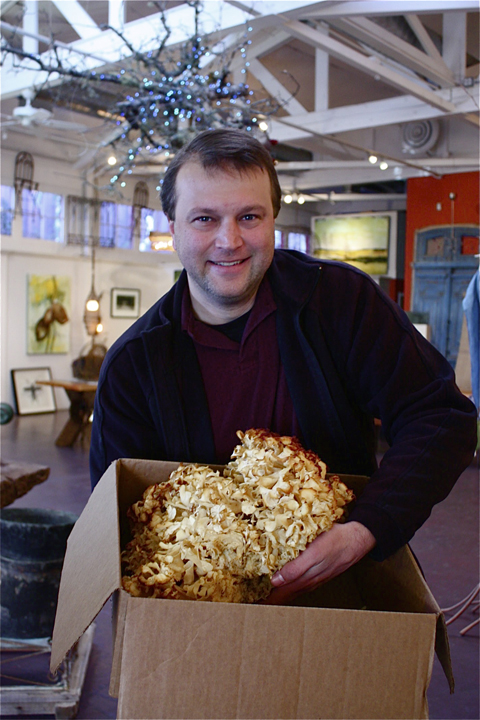Dish of the Week
Wild Mushrooms
 Growing up in LA I had a good friend whose father often disappeared on weekends to go mushroom hunting. Everybody, including his wife, thought it was the weirdest thing to do. This was in the years before being weird was cool; a few years before ‘shrooming’ took on a whole other significance.
Growing up in LA I had a good friend whose father often disappeared on weekends to go mushroom hunting. Everybody, including his wife, thought it was the weirdest thing to do. This was in the years before being weird was cool; a few years before ‘shrooming’ took on a whole other significance.
I think about my friend’s dad from time to time because looking back now I realize he was the only person I’d ever met that went into the wild to look for food. Foraging was something people only did when they didn’t have access to a supermarket; it never would have occurred to me then that it might even be preferable to needing one.
 There’s no telling what he would think if he were around today, with mushroom foraging weekends offered up and down the North Coast, wild mushroom classes in every cooking school, and shelves in local bookstores stocked with books on mycology. Last week I even heard tell of an app that can identify mushrooms you find in the wild instantly by simply uploading an image of them. Here in Healdsburg, as part of Epicurean Winter, for one week in February (Mushroom Week!) you will be able to restaurant hop across town, eating a different dish starring a locally foraged mushroom at each stop.
There’s no telling what he would think if he were around today, with mushroom foraging weekends offered up and down the North Coast, wild mushroom classes in every cooking school, and shelves in local bookstores stocked with books on mycology. Last week I even heard tell of an app that can identify mushrooms you find in the wild instantly by simply uploading an image of them. Here in Healdsburg, as part of Epicurean Winter, for one week in February (Mushroom Week!) you will be able to restaurant hop across town, eating a different dish starring a locally foraged mushroom at each stop.
But for certain folks, like Corey Gates and the generations of families like his, who have lived and foraged in Northern California for the past century, mushroom hunting has never been geeky or a food fad. It has always been just a part of their lives, a cherished piece of their culinary history.
Corey’s grandmother first took him foraging for wild Chanterelles at the age of three; over the years she taught him all she knew, making him swear never to reveal their secret spots ~ always the number one mushroom hunting rule, which took on extra significance after she died. For Corey, foraging for mushrooms went from a hobby to a passion to a business, The Mushroom Hunters.
On Tuesday he stopped by to show me his bounty from what he considered to be a good day foraging the mountains around Ukiah. All but one belonged to the genus Cantharellus, aka Chanterelles. He had California Golds (C. formosus); Black Trumpets (C. cornucopioides); rarer whites (C. subalbidus) and Yellowfoot (C. tubaeformis). He was most proud of the beautiful cream colored Hedgehogs (Hydnum repandum), which are technically not in the same genus. They are great eating mushrooms, if you don't get put off by the tiny razor teeth which make them look like they belong in a Tim Burton movie. Hedgehogs are delicious, with a wonderful earthy, almost nutty aroma.
Ryan loves to caramelized wild mushrooms; in truth he is not a big fan up cutting them up because they can go too soft as they sweat, resulting in a less than desirable texture. Cut up they are best when used in a sauce, or a dish like Ragu where the flavor is paramount. With a few exceptions he prefers his mushrooms small, the better to be served whole. He likes Morels in a nice Madeira sauce, rich and creamy; his Girolles and King Trumpets grilled, preferably over an open flame; meaty Hen of the Woods, sweet Chanterelles and woody Porcinis are best for him roasted, lightly dressed with a nice sherry vinaigrette. Last week he quickly sautéed white Chanterelles serving them with a crispy duck leg, sliced duck breast and root vegetables on onion soubise.
 A few months ago I wrote a bit about the complex taxonomic history of fungus and their mycorrhizal (symbiotic) relationship to the conifers, oaks and redwoods that grow in abundance throughout the North Coast. Sonoma, and especially Mendocino counties benefit greatly from mixed new and old growth forests. That, along with our mild extended winters make this part of the world prime mushroom hunting terrain ~ hell, it's almost impossible to take a walk in the country from January on and not come upon some growing wild. All the more reason to learn some salient features it takes to begin to identify them. Forget eating any wild mushroom you haven't foraged with an expert ~ just identifying them can be great fun. Check out the graph below courtesy of (thankfully still) free file sharing Wikipedia. Learn how to forage and if nothing else, you'll never go hungry in the forest. (As long as our forests are there ~ but that's another blog altogether).
A few months ago I wrote a bit about the complex taxonomic history of fungus and their mycorrhizal (symbiotic) relationship to the conifers, oaks and redwoods that grow in abundance throughout the North Coast. Sonoma, and especially Mendocino counties benefit greatly from mixed new and old growth forests. That, along with our mild extended winters make this part of the world prime mushroom hunting terrain ~ hell, it's almost impossible to take a walk in the country from January on and not come upon some growing wild. All the more reason to learn some salient features it takes to begin to identify them. Forget eating any wild mushroom you haven't foraged with an expert ~ just identifying them can be great fun. Check out the graph below courtesy of (thankfully still) free file sharing Wikipedia. Learn how to forage and if nothing else, you'll never go hungry in the forest. (As long as our forests are there ~ but that's another blog altogether).
All text Jil Hales. All photos Jil Hales and Dawid Jaworski (unless otherwise noted).






